TQUARCHESS
A Chess Variant By Simon Edward JeppsDownload ~ PDF ↷ ⋱
Introduction
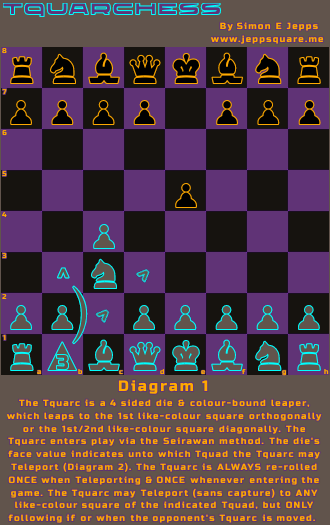 The Tquarc is a four-sided (pyramidical) die {D4} with truncated points to improve rolling ability. Today these kinds of dice are very beautiful, like gem stones or even two-toned marble. I will show you a small selection at the Summary.
The Tquarc is a four-sided (pyramidical) die {D4} with truncated points to improve rolling ability. Today these kinds of dice are very beautiful, like gem stones or even two-toned marble. I will show you a small selection at the Summary.
The Tquarc is itself a Chess piece which enters the game via the Seirawan method - occupying the newly vacated square of any back-rank piece in the same move the back-rank piece first vacates (Diagram 1). There is only ONE Tquarc per player, but there are now TWO ways to promote a piece unto Tquarc.
The Tquarc is a colour-bound leaper, which leaps to the 1st like-colour square orthogonally or the 1st/2nd like-colour square diagonally. The die's face value indicates unto which Tquad the Tquarc may Teleport (Diagram 2).
The Tquarc is ALWAYS re-rolled ONCE when Teleporting & ONCE whenever entering the game. The Tquarc may Teleport (sans capture) to ANY like-colour square of the indicated Tquad, thus maintaining colour-boundness - however it may ONLY Teleport following if or when the opponent's Tquarc is moved, in response.
The Tquarc may ONLY be re-rolled when Teleporting or when entering play, assuming a new Tquad value from the new square and MUST be re-rolled only ONCE in that move; a re-roll when Teleporting IS mandatory. Likewise, whence awaiting its first entry, or whence promoting either a Pawn or Knight (Diagram 3), the Tquarc MUST be re-rolled ONCE whenever making an entry attempt.
As per Seirawan method rules, once all back-rank pieces have vacated their starting squares for the first time, all eight opportunities to enter/re-roll your Tquarc will have expired (Diagram 1). So MAKE SURE you ENTER your Tquarc into the game REGARDLESS of its rolled value BEFORE this time, else you sacrifice your right to do so.
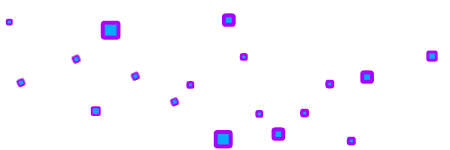
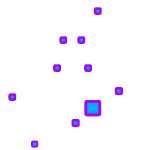
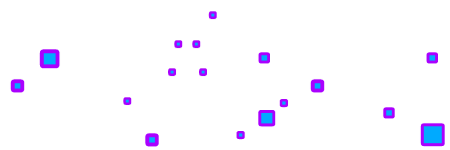
Teleportation
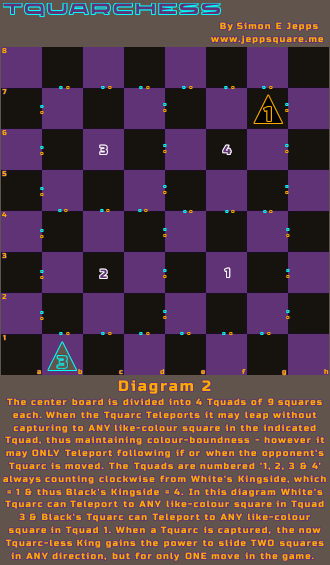 The center board is divided into 4 Tquads of 9 squares each. The Tquarc's face value indicates unto which Tquad the Tquarc may Teleport (Diagram 2).
The center board is divided into 4 Tquads of 9 squares each. The Tquarc's face value indicates unto which Tquad the Tquarc may Teleport (Diagram 2).
When the Tquarc Teleports it may leap without capturing to ANY like-colour square in the indicated Tquad, thus maintaining colour-boundness - however it may ONLY Teleport following if or when the opponent's Tquarc is moved, in response.
The Tquarc MUST be re-rolled ONCE whenever Teleporting & ONCE whenever entering play.
The Tquads are numbered '1, 2, 3 & 4' always counting clockwise from White's Kingside, which = 1 & thus Black's Kingside = 4. In Diagram 2 White's Tquarc can Teleport to ANY like-colour square in Tquad 3 & Black's Tquarc can Teleport to ANY like-colour square in Tquad 1.
Whence a Tquarc Teleports, the move is notated with a percent suffix (%) followed by its new value. For example if a White Tquarc Teleported from f3 (Tquad 1) to b7 (Tquad 3), whilst re-rolling a '4' en-route, the move would be notated Tb7%4.
Likewise when a Tquarc enters the game for the first time its rolled value must be indicated. For example, if the Tquarc enters to the White Queen's Bishop square when the Bishop makes its first move, say Bishop to g5, and the Tquarc's value shows '3', this entry would be notated Bg5/T%3. Yes, the first entry counts as a Teleport.



2-Square King
Now beware the 2-square King..!Once a player's Tquarc has been captured, the now Tquarc-less player's King gains the ability to slide a maximum of TWO squares in ANY direction, but only ONCE - thus only for ONE move of the player's choosing during the remainder of the game (Diagram 3).
 This special King move exists for two reasons:
This special King move exists for two reasons:
- To inject some mediating fire into the battle for dominance.
- To resurrect a fair & ancient Indian tradition.
However in Tquarchess the King may NEVER jump.



Resurrection
Tquarcs can resurrect from capture; firstly when Pawn promotion, but ALSO a KNIGHT can resurrect a Tquarc by arriving to any ally-colour square of the opponent's back rank & self-promoting to a Tquarc (Diagram 3). Thus if White, your Knight could arrive to a8, c8, e8 or g8 to then promote it to a Tquarc.For example, the promotion shown in Diagram 3, where the White Knight moves to the White a8 square and promotes to a Tquarc - let's say with a rolled value of '2' - would be notated Na8/T%2.
Herewith, since a King gains the power to slide TWO squares for ONE move only after a Tquarc has been captured, this power-invent is thus cancelled until the Tquarc is captured again. This special King power can ONLY be used ONCE per game, regardless of any repeated captures. Likewise, a player is only ever allowed ONE Tquarc on the board during any game.



Summary
Ahh, now behold my trusty leather pouch set and a good selection of Tquarcs. Forever a warming companion on my voyage.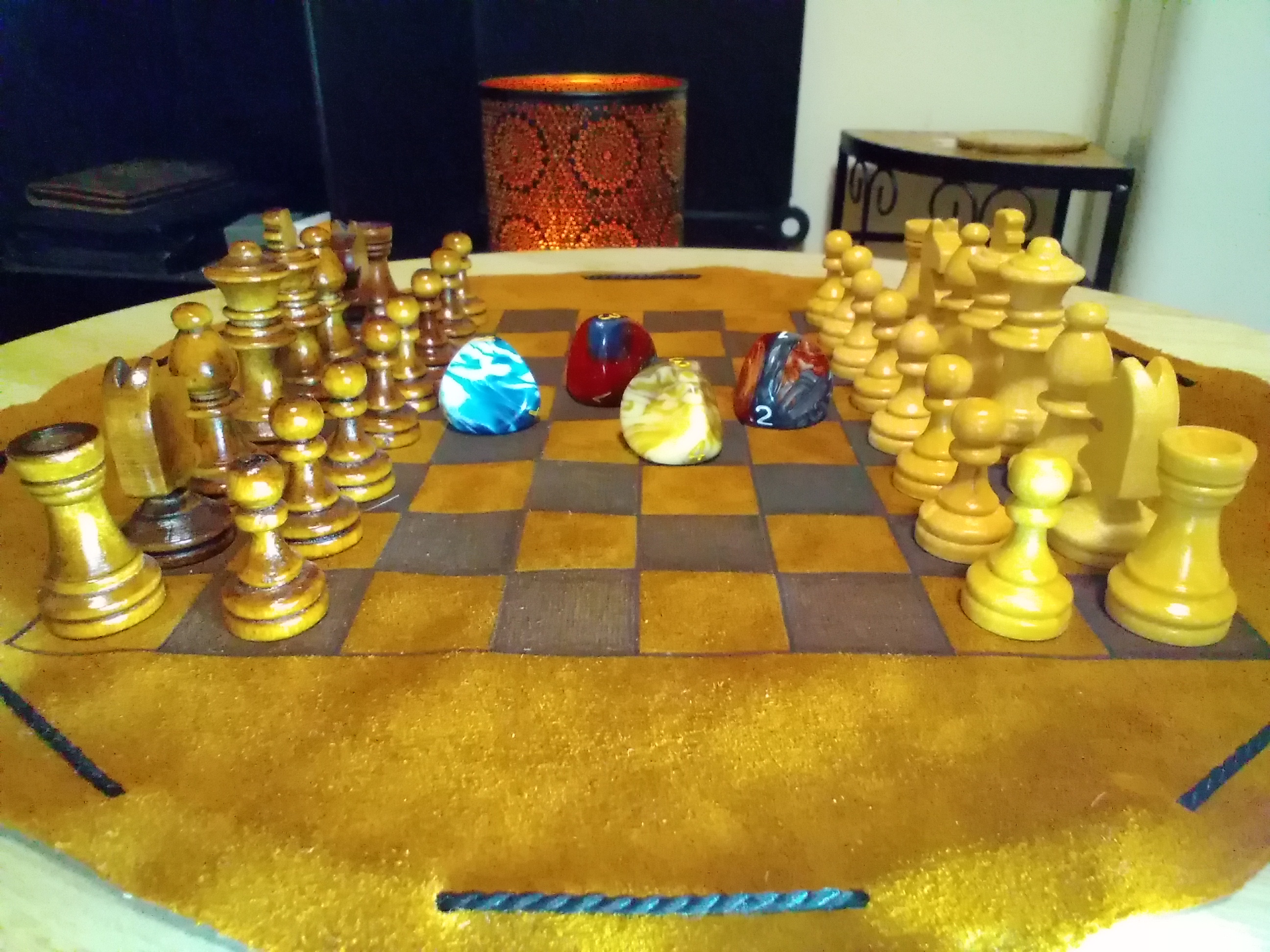 I have spoken often about how the 8x8 board is an undying perfection, an almost "sacred" permanence, never surrendering its ancient romantic purity unto any larger arena of heavy feet, illogical noise and lost principles.
I have spoken often about how the 8x8 board is an undying perfection, an almost "sacred" permanence, never surrendering its ancient romantic purity unto any larger arena of heavy feet, illogical noise and lost principles.
Indeed however, the mission of my Jeppsquare blog is to study, investigate, devise and hopefully discover a truly pure working evolution of the classic game. I have devoted many, many years of my life to this pursuit.
A common argument I make for evolving the game (amongst many others) is how the Knight piece is in fact compromised from move one, in that it realistically only has ONE good square to make its first move (K/QB3) and even this often results in it becoming pinned ~ an unfortunately well founded repetitive theme in many or most games.
Yet at the same time, classical Chess wouldn't have remained so popular if this minor aspect was too much of an irritation. Thus for those who say it is and indeed many a tournament player may well say so, Tquarchess offers a way around this thorn and furthermore all other thorns of the academically suggested "played-out" and "dying" game.
Aye a new piece and one which mitigates these negative arguments by providing alternative ways of addressing and remedying these common depressions in the orthodox game.
Take for example an early Berlin-style Queen exchange ~ yet whence a Tquarc enters to b1, b8, f1 or f8 the Queen becomes defended and the King freed from the chains which once bound him to an unfortunate obligation of recapture (Diagram 1).
I truly believe the problem with inventing and adding new pieces to the game is that not only does a 10x10 board present evermore evolutionary problems but whatever 'figurine' you design for the 8x8 it will always seem out of place. This is because it doesn't already have a natural resident square or naturally suggested move upon the board.
Yet it is also true that Chess is imbalanced with many sliding pieces yet only one leaper piece and only one colour-bound piece. Thus a colour-bound leaper is not only paramount to the game but its character must be one of genuine compatibility.
Herewith, the Tquarc is perfect because firstly it replenishes the balance of leapers/sliders/colour-bounds with a mathematically crafted logical footprint and secondly it righteously excludes itself from the 'figurine' suite in assertation of a more naturally descriptive & compatible appearance of character.
Which is of course a magical mathematical entity of alternative dimension... And beauty.
For long ago, in a world far, far away, Chess was just being born and amongst the wise sages of profoundest spirit & culture, the Grandmasters of Indian Chaturanga began to play Chess with dice.
Perhaps then, the way forward has always been the way of origin. I think so.
Thank you for reading.
 |  |



